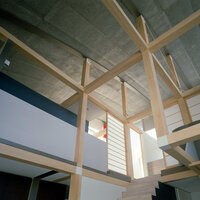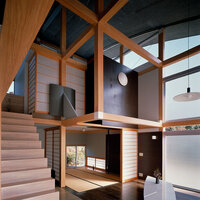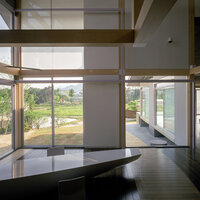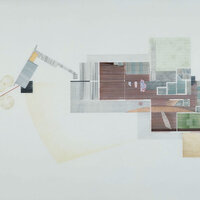House at Kogajo
Kamo-gun, Hiroshima, JAPAN
Home - Life stage
| Architect | Nobuaki Furuya + N.Furuya Lab.,KinKi Univ. |
|---|---|
| Usage | House |
| Structure | W |
| Size | 2F |
| Site area | 737.00㎡ |
| Area | 134.22㎡ |
| Completion | 1990.05 |
| Award | The 8th Yoshioka Award (currently Shinkenchiku Award),1991 |
| Publishing | Jutakutokushu 1990.08, Kenchikubunka 1990.08, SD 1990.08 |
A woman is silently walking on the stage. There is nothing on the stage other than her presence. Shortly after that, other actors appear on the stage, with doors, paper screens and chest of drawers in their arms. Arranging a set of furniture, the stage suddenly starts to look like a ‘house'. This ingenious and exciting device was shown in the very first scene of Shogo Ota’s drama ‘Komachi Fuden’ (Tenkei theatre). In this house, they eat, sleep and do other routine chores as we all do in our houses. At the end of the play, however, the actors take away the furniture they brought in, leaving the bare stage.
As it is a stage performance, the way people move in and out of the house is quite exaggerated. Nevertheless, this first scene says almost all I want to say about ‘life’ and ‘houses,’ which is the stage for the performance of our daily life. It was when I was about to finish designing the house of Kogajo that I saw the play for the first time. I had always wanted to, but I had never had an opportunity to do so. As the theatrical company intended to break up after giving all of the scheduled performances, I was fortunate to get a chance. At the same time, however, I strangely thought that I had been right about not seeing the play until that time. What I want to say is that I had enjoyed imagining the ‘house’ in my mind by listening to my friends’ descriptions about it before I actually saw the play. Thus, my joy at ‘encountering’ the house was doubled thanks to imagination.
The empty lot I was going to build the house of Kogajo on was in the middle of a slope. It was surrounded by a newly constructed residential area, which was built after clearing a section of a forest. As the owner had not sold the lot, it looked like a small pond in a forest of houses. On the lot was a path, which led to a sloping coppice running across the residential area. Although it was unfortunate that the trees, including pines, had been cut down, the lot did afford a fine view of neighbouring paddy fields and meadows. Moreover, beyond the newly built houses behind the lot, we could enjoy a mountainous panorama. On seeing the site, I said, ‘Let’s not level this ground. I think we should keep the lot sloping’. The image that occurred to me was of a house whose foundation would be raised so that the house would not be tilted, and whose two roofs should be installed in harmony with the mountain range.
The house I was going to build was not a vacation house. It would be a place in which the residents lead their everyday life. In my opinion, we never lead the same life. I mean, today is different from yesterday even though it appears quite similar. A child grows every day, and so do adults. A room in which we feel comfortable in winter might be unpleasant in summer. We do not need to sleep in the same bedroom throughout the year, let alone eat in the same dining room. In fact, as I had not designed a residence until that time, it took me some time to set to work, meditating on such questions. In designing this house, I reconsidered my ideas about what a house should be. Therefore, in it there are no rooms for particular uses apart from the kitchen, bathroom, and toilet. I installed no more than two hinged doors. All the other doors were sliding doors, which, depending on the resident’s preference, could be opened or remain closed. They can even be removed. Thus, how to divide the room would be up to the residents. When they looked up, however, they would recognize that every room is connected under one big ceiling. Also, they would feel that their house is connected to the outside world through the ‘mado’. Although ‘mado’ is usually translated to the English word ‘window,’ what I mean by ‘mado’ is a partition or a room divider, rather than a window. I installed these partitions wherever they were needed in order to prevent light, wind, rain, noise, and anything which disturbs privacy, from invading. As you can see, the doors or the partitions are basically different from the windows. Whereas the latter signifies a hole in the wall through which something can slip in and out of the rooms, the former is used to shut out or prevent something from intruding. Moreover, various types of doors such as wooden doors, lattice doors and traditional Japanese paper doors, can be selected, and they can be removed when they are no longer needed. As a result, the partitions I prepared were made shorter than ordinary doors in order that they could be moved in and out the rooms quite easily. In this way, these partitions can be regarded as furniture rather than as a part of the structure. The house was not surrounded by forest but adjoined other residences. Besides, some rooms cannot always be left open. This was why we needed many partitions in and around the house. The two roofs of the house were supported by massive pillars, and between the pillars were partitions of various sizes, creating patchwork-like walls.
So far, I have brought many partitions onto this ‘stage’. Fujie and Veronica who made furniture also carried their ‘uniqueness’ into the house. After moving in, husband and wife have been busy arranging their house into memorable ‘parts’. Their three dogs have finally arrived. The second scene of the house begins today. I hope they will continue ‘making’ the house until the day when it is again emptied out.
Photos: Shinkenchikusya











